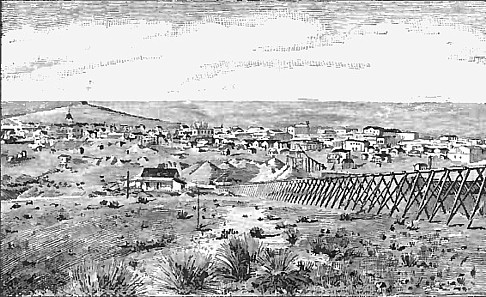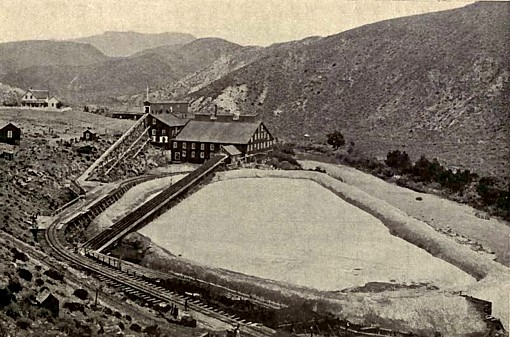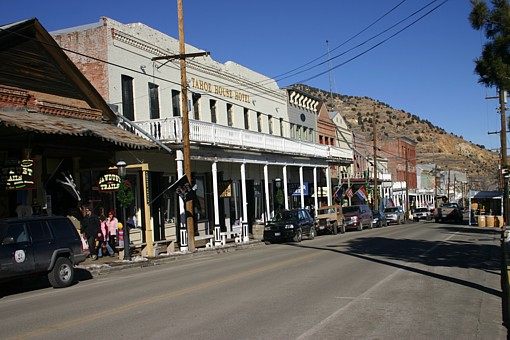When news began to be received in various parts of California from the first parties of these adventurers, upon their arrival in Washoe, their reports were confirmatory of all that had before been said and imagined of the new mines, and an almost unparalled excitement followed. Miners, business men, and capitalists flocked to the wonderful land of silver that had been found in the wilderness of Washoe, beyond the snowy peaks of the Sierras. The few hardy first prospectors soon counted their neighbors by thousands, and found eager and excited newcomers jostling them on every hand, planting stakes under their very noses and running lines round or through their brush-shanties, as regardless of their presence as though they were Piutes. The handful of old settlers found themselves strangers, almost in a single day, in their own land and their own dwellings. There were numerous sales of mining claims almost daily, at what then was thought high prices, and the hundreds who were not provided with money with which to purchase mining ground swarmed the hills in search of ledges that were still undiscovered and unclaimed. The whole country was supposed to be full of silver lodes as rich as the Comstock, and the man who was so fortunate as to find a large unoccupied vein, containing rock of a color similar to that of the Ophir, considered his fortune made.
The Mining Recorder of the district now drove a thriving trade; he could hardly record the locations of mining claims as fast as they were made. Some of these notices were literary curiosities, particularly those to be found in the old Gold Hill book of records. V. A. Houseworth, the "village blacksmith," was the first Recorder at Gold Hill, and the book of records was kept at a saloon, where it lay upon a shelf behind the bar. The "boys" were in the habit of taking it from behind the bar whenever they desired to consult it, and if they thought a location made by them was not advantageously bounded they altered the course of their lines and fixed the whole thing up in good shape, in accordance with the latest developments.
When the book was not wanted for this use, those lounging about the saloon were in the habit of snatching it up and "batting" each other over the head with it. The old book is now in the office of the County Recorder, at Virginia City, and is beginning to be regarded as quite as curiosity. It shows altered dates, places where leaves have been torn out, and much other rough usage. The majority of the notices of location recorded by the early miners are very vague. The first notice recorded in the book is one of the location of a spring of water by Peter O'Riley and Patrick McLaughlin. It reads: "We the undersigned claim this spring and stream, for mining purposes." Nothing is said about where the spring is located.
For aught the person reading the record can discover, it may be in California or Oregon. In the book are scores of locations made and recorded in the same loose manner. Many of the recorded notices read : " We the undersigned claim 2,000 feet on this quartz lead, ledge, lode, or vein, beginning at this stake and running north." Not a word is said about where the stake is to be found. No wonder that the lawyers drove a thriving trade in the early days of Washoe ! During the progress of a mining suit in the early days the lawyers quarreled for nearly two days about a certain stump from which one of the parties to the suit desired to begin the measurement of their claim. They produced witnesses who said they could identify the stump, and the next morning the court adjourned, and jury and all concerned went out to take a look at the landmark in question. No stump could be found. The parties of the opposite side had dug it up the night before and packed it away. Not even the spot where it was supposed to have stood could be found, so completely had the ground been leveled in all directions.
I give the following verbatim copy of the original location notice of the Yellow-Jacket mine a mine that has yielded many millions of dollars as it stands on the old Gold Hill records : NOTICE. That we the undersign claim Twelve hundred (1200) feet of this Quartz Vain including of of its depths & Spurs commencing at Houseworth claim & running north including twenty-five feet of surface on each Side of the Vain. This Vain is known as the Yellow Jacket Vain. Taken up on May 1st. 1859 recorded June 27th, '59. H. B. CAMP. JOHN BISHOP. The claim was called the Yellow Jacket because of the fact of the locators finding a nest of yellow-jackets in the surface rock while they were digging about for the purpose of prospecting the vein. Future developments proved this claim to be on the Comstock lode.
What the locators meant by " depths," in their notice, was dips no matter in what direction the "vain" might dip, they desired to put on record their right to follow it. Many notices read "This vein with all of its dips, spurs, angles, and variations." The word variations' was presumed to capture everything in the vicinity. A practice prevailed among the early miners of locating quartz ledges as "twins." This was when they found two parallel veins so near together that they feared, in case of their locating but one, that parties would take up the other and give them trouble in some way. None of the twins ever became famous. The owners of the Ophir, and some of the adjoining claims on the Comstock lead, continued to use rockers and arastras for some time after it was ascertained that what was at first supposed to be worthless, was silver ore of the richest description, but they no longer threw the "blue stuff" away. It was all saved and sacked up for shipment to San Francisco, thence to England for reduction.
Many arastras were running, and the camp soon presented quite a bustling appearance. The first house erected in Virginia City, was built by Lyman Jones, who is still a resident of Nevada. It was a canvas structure, 18 x 40 feet in size, and stood near the present corner of B Street and Sutton Avenue, at no great distance from the Ophir Mine. It was kept as a boarding-house and saloon. Mr. Jones opened his house with two barrels of "straight" whisky, but being of an accommodating disposition and wishing to suit all tastes, he dignified the contents of one of these barrels with the name of brandy. As alcohol was the foundation of nearly all the liquors seen in the country at that time, it made little difference by what name they were announced to the consumer, Mr. Jones had an old sluice-box for a bar, and the bar fixtures were by no means numerous or costly. At this time the Ophir Company were in the habit of bringing their gold dust to Mr. Jones's house, and leaving it for safe-keeping, and frequently he had in his place as high as twenty and thirty thousand dollars.
As the walls of his "hotel" were constructed of nothing more substantial than a single thickness of cotton cloth, safer places might have been conceived of, in which to deposit such an amount of gold. At length, when the grand gold rush from California came, and adventurers of all kinds swarmed along the lode, Mr. Jones refused to any longer act in the capacity of banker to the Ophir folks, as he did not care to run the risk of having his throat cut for gold not his own, in fact did not want his throat cut at all. At first it was almost impossible to procure lumber of any kind for building purposes, and the houses erected were principally of canvas ; though a few rough stone-houses were soon built and the miners constructed cabins of the rough rocks lying about on the sides of the hills. Many dug holes a few feet square in the sides of steep banks, and covering these with a roof of sage-bush and dirt announced themselves " at home " to their friends. As winter came on, not a few who had been living in tents or the open air, betook themselves for shelter to the tunnels they had begun to run into the hills; widening out a place at some distance back from the mouth for bedroom and parlor.
Some of those who thus made habitations of tunnels did their cooking in the open air, under a brush-shed placed in front ; others, displaying more industry and ingenuity, made a kitchen some distance back in their underground quarters, working a hole up to the surface of the earth, through which the smoke of their fire found egress, presenting the curious appearance of a small semi-active volcano, when seen at a distance by one who knew nothing of the subterranean lodging-house whence the smoke proceeded. In 1859, when the discovery of silver was made, the only wagon-road in all the country was the old Emigrant Road ; coming in across the Plains, passing through Carson Valley and thence ascending and crossing the Sierra Nevada Mountains to California, by the way of Placerville. Virginia City being situated on a sort of sloping plateau, on the eastern face of Mount Davidson, at the height of over 6000 feet above the level of the sea, was a place difficult of access.
Wagons could be used in the surrounding valleys, but Virginia City could receive no freight except such as could be carried up the mountain on the backs of pack-mules. Soon after the discovery of silver, however, companies located routes for wagon-roads to the place, and began the difficult work of building them, blasting out passage-ways in many places through solid rock along the sides of canyons shut in by almost perpendicular walls. Men swarmed on these roads during their construction, the explosion of heavy blasts was almost constant along the canyons, and it was not many months before they were completed, when lumber, timber, and many other much-needed articles, that could not be packed on the backs of mules, poured into Virginia City whose streets were soon crowded with huge "prairie schooners" as the great mountain wagons are called drawn by long lines of mules or horses, all musical with bells. The completion of a practicable wagon-road to Virginia City was at that time considered a great achievement, but now locomotives rush and shriek round the mountain steeps up which the patient mules tugged and groaned in former days. Return
to The Nevada Mining Rush Page:
Nevada Gold Rush Mining History



